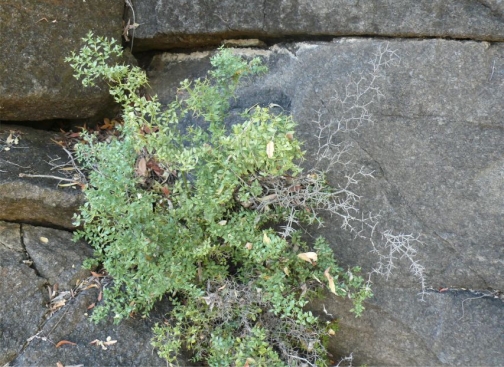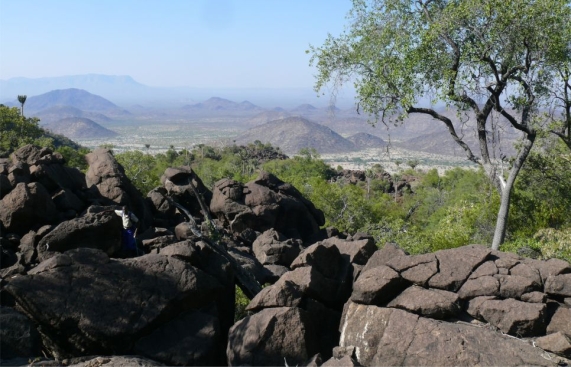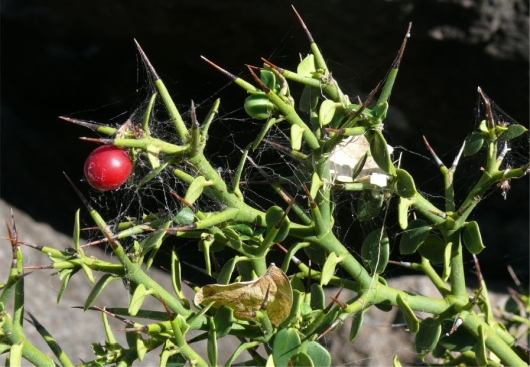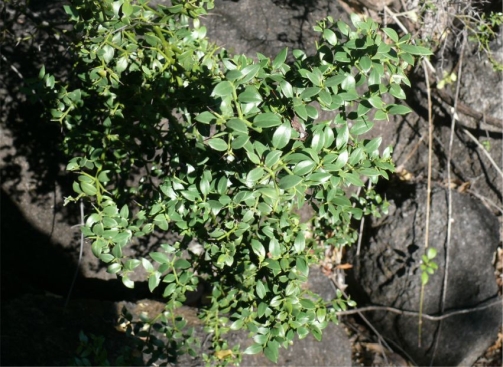Carissa sebrabergensis
Carissa sebrabergensis Van Jaarsv. & Swanepoel
Family: Apocynaceae
Common names: Sebraberg numnum (Eng.); Sebraberg-noemnoem (Afr.)
Introduction
The Sebraberg numnum is a rare shrub from the Sebraberg in northern Kaokoveld, Namibia. It is a diminutive, layered evergreen, spiny shrub, with small glossy leaves, fragrant, white, star-shaped flowers in late summer and autumn, and red, edible berries. It is easy to grow and makes a rewarding, ornamental shrub which is best for warm, subtropical and bushveld gardens in dappled shade, and can be grown a hedge.

Fig. 1. Illustration of Carissa sebrabergensis by Marieta Visagie, drawn from live plant material grown from seed collected in the Sebraberg, northwestern Namibia.
Description
Description
Carissa sebrabergensis is a much-branched, dichotomously branching, leafy, spiny, evergreen shrub, to 2 m tall, from a solitary main stem. The young stems ascending, with zig-zagging and layered ramification, surface green, minutely hairy; older stems becoming grey. The sap is milky. Main branch 25 mm in diameter at base, often with erect side shoots arising from near the base. The bark is grey, wrinkled. The spines simple to once forked, 5–7 mm long, persistent. The branches and branchlets are uniquely layered, often zig-zagging. The leaves are ascending spreading, leathery, linear ovate, 10–18 × 2–7 mm. The petiole is short, about 1 mm long, the leaf blade sparsely and finely hairy becoming hairless (glabrous) with a shiny surface, paler below. The leaf margin with minute hairs, the main vein semi-translucent. The leaf base rounded to blunt (obtuse) and the leaf tip is sharp, bearing a small point (mucronate). The flowers in clusters at the ends of branchlets. The bracts are egg-shaped and drawn to a point (acuminate), 1.5–2.0 × 0.5 mm. The calyx is 3 mm long, the lobes lanceolate acuminate, 1.5 mm long, with a few glandular hairs. The flower (corolla) is white, salver-shaped, up to 9 mm in diameter, the tube is slender 5.3–7.2 × 1.4–1.6 mm, minutely hairy (pilose), the throat beset with longer white hairs, 0.5 mm long. The floral lobes are egg-shaped (ovate), spear shaped (lanceolate), spreading, 3–5 × 1.3–1.8 mm. The stamens 5, inserted at the top of the tube. The gynoecium (female portion) 4.1 mm long, ovary entire, 2-chambered, style filiform, stigma stipitate. Fruit round (spherical), 10 mm in diameter, more or less of the same length, glossy, red, 1–2-seeded. Flowering is mainly from late summer and autumn (April southern hemisphere).

Fig. 2. Carissa sebrabergensis in habitat on the Sebraberg, Kaokoveld, northwestern Namibia. Photo E.J. van Jaarsveld
Conservation Status
Status
Carissa sebrabergensis is locally common and not threatened.
Distribution and habitat
Distribution description
Carissa sebrabergensis is only known from the Sebraberg, Kaokoveld northwestern Namibia. its distribution lies in the tropics, with very hot summers and warm, frost free winters. The rainfall is between 100–400 mm per annum, received mainly during the summer and autumn months (Mendelsohn et al. 2002). The fertile, volcanic soil allows for many palatable grasses, shrubs and tree species. Characteristic of the Sebraberg vegetation is the spiny component. Plants have evolved spines in reaction to disturbances from herbivores. Spinescent trees and shrubs associated with the Sebraberg numnum include Sansevieria pearsonii, Senegalia mellifera subsp. detinens and S. ataxacantha, Chaetacme aristata, Obetia carruthersiana, Vachellia kirkii and species of Solanum, Barleria and Hibiscus. Succulent plants encountered include Aloe littoralis, Adenium boehmianum, Cyphostemma currorii, Euphorbia eduardoi and Kalanchoe lanceolata. Carissa sebrabergensis grows on steep slopes, often in dappled shade, and in kloofs, in the shade of trees and larger shrubs.

Fig. 3. Carissa sebrabergensis in typical habitat, among anorthosite boulders in a kloof. Photo E.J. van Jaarsveld
Derivation of name and historical aspects
History
The genus Carissa was established by Linnaeus in 1767 and represents the Sanskrit name for Carissa carandas from India (Clarke & Charters 2016). Presently the genus consists of about 35 shrubby species. The Apocynaceae, to which our species belongs, has been divided into 5 subfamilies. These include Rauvolfioideae, Apocynoideae, Periplocoideae, Secamonoideae and Asclepiadoideae. Carissa belongs to subfamily Rauvolfioideae (Christenhusz et al. 2017).
Carissa sebrabergensis was named by Wessel Swanepoel and the author in 2021, in the Flowering Plants of Africa journal. This shrub was encountered on a joint expedition to the Sebraberg, Kaokoveld, Namibia in May 2012 when we decided to investigate this interesting, unique mountain.
The name Sebraberg is derived from its particular weathering; the mountain sides have characteristic vertical scree slopes, interfaced with the mountain slope, giving it from a distance, a striped appearance and hence the name Sebraberg (meaning ‘zebra mountain’). The geology of this mountain is also unique, and represents one of the world’s largest anorthosite massifs (Kunene Complex) (Miller & Schalk 1980, Mendelsohn et al. 2002). These volcanic rocks gave rise to a rich, basic clay soil. Our expedition to the Sebraberg was also joined by Liudmila Ozerova from the Moscow Botanical Garden, Leevi Nanyeni from the Namibia National Botanical Research Institute (Windhoek) and Gregory Nicolson, freelance ecologist from the Western Cape, South Africa. Whilst climbing the southern slopes in Kloof-sonder-end we came across this spiny shrub, realising it was a species of Carissa. The author took a few fruits and cuttings. These were gown at Kirstenbosch National Botanical Garden and later at Babylonstoren Farm where we grow the plant outside in the Welwitschia Garden. When it came into flower, it was illustrated by Marieta Visagie and a description could be drawn up. In cultivation the plant retains its characteristic small leaves and peculiar branching and spiny growth.
Due to the spiny nature of the vegetation of the Sebraberg, the best route of access is to remain in the boulder fields.
Carissa sebrabergensis can immediately be distinguished from Carissa bispinosa by its dwarf stature (usually under a metre in height); its branches that are uniquely layered, often zig-zagging; its fruits that are rounded to rounded-oval, up to only 10 mm in diameter; and its unique habitat among anorthosite boulders. Carissa bispinosa which also grows wild in Namibia is the most widespread and common Carissa in southern Africa and is immediately identified by its spines that are forked once, white flowers of which the tube is 6–9 mm long and the lobes up to 5 mm long, and ovate red fruits that are 10–16 mm long.

Fig. 4. Carissa sebrabergensis in fruit, Sebraberg, northwestern Namibia). Photo E.J. van Jaarsveld
There are 6 known species of Carissa indigenous to South Africa. These include C. bispinosa, C. haematocarpa, C. macrocarpa, C. spinarum (= C. edulis), C. tetramera and C. wyliei. All Carissa species produce edible fruit and the largest and most popular is C. macrocarpa, the amatungula or groot-noemnoem, from the coastal parts of the Eastern Cape and KwaZulu-Natal. There are 4 species of Carissa known for Namibia, C. bispinosa, C. haematocarpa, C. sebrabergensis and C. spinarum (Mannheimer & Curtis 2009; Bruyns 2014).
Ecology
Ecology
The Sebraberg numnum is a rigid spinescent shrub (forked spines) efficient in warding off herbivores. Should fire on occasion be present the plant simply re-sprouts from its base. The small, tubular, white flowers are presumably pollinated by night-flying insects such as moths. The reddish fruits are edible and dispersed by birds, tree squirrels and primates. The peculiar branching of Carissa sebrabergensis, apart from avoiding herbivores, is perhaps also an adaptation for conserving moisture in this very hot, semi-desert climate.

Fig. 5. Carissa sebrabergensis showing the leaves. Photo E.J. van Jaarsveld
Uses
Use
No medicinal or cultural uses have been recorded.

Fig. 6 Carissa sebrabergensis growing in the Biomes Garden at Babylonstoren Farm, near Simondium in the Western Cape. Photo E.J. van Jaarsveld
Growing Carissa sebrabergensis
Grow
Carissa sebrabergensis is an easily grown shrub, both in the garden and as a container plant, and, so far, with its small stature and layered, evergreen growth of small glossy leaves, fragrant white flowers and red berries, shows promise as a garden ornamental. It is also very drought-tolerant and adapted to grow in very hot conditions. It was planted at Babylonstoren in 2016 where the shrubs flowers profusely. It retains its peculiar layered branching, small leaves, white flowers and fruits. Best to grow in warm bushveld or subtropical gardens in dappled shade.
Adam Harrower, curating the succulents at Kirstenbosch, had success in propagating the plants from softwood cuttings rooted in peat and polystyrene, placed in a heated mist bed. Sow seed in spring, summer or autumn in a sandy mixture. Place container in a shady position but with full light. Germination is usually within 3 weeks. Once big enough to handle the young plants can be planted out in a general nursery soil mixture.
References
- Bruyns, P.V. 2014. The Apocynaceae of Namibia. Strelitzia 34. South African National Biodiversity Institute, Pretoria.
- Burchell, W.J. 1822–1824. Travels into the interior of southern Africa. 2 vols, London.
- Christenhusz, M.J.M., Fay, M.F. & Chase, M.W. 2017. Plants of the World, an illustrated Encyclopedia of vascular plants. Kew Publishing, Royal Botanic Gardens, Kew.
- Clarke, H. & Charters, M. 2016. The illustrated dictionary of southern African plant names. Flora & Fauna Publications Trust, Jacana, Johannesburg.
- Coates Palgrave, K. 2002. Trees of southern Africa. Struik, Cape Town.
- Leeuwenberg, A.J.M. & Van Dilst F.J.H. 2001. Series of revisions of Apocynaceae XLIX Carissa L. Backhuys Publishers, Leiden.
- Linnaeus, C. 1767. Systema naturae per regnae tria naturae. Editio duodecima, reformata. Tomus 2 (Regnum vegetabile). Holmiae.
- Mannheimer, C. & Curtis, B. 2009. Le Roux and Muller’s Field Guide to the Trees & Shrubs of Namibia. Macmillan Education, Windhoek.
- Mendelsohn, J., Jarvis, A., Roberts, C. & Robertson, T. 2002. Atlas of Namibia. David Philip, Cape Town.
- Miller, R. McG. & Schalk, K.E.L. 1980. Geological map of South West Africa/Namibia. Geological Survey of the Republic of South Africa and South West Africa/Namibia.
- Smith, C.A. 1966. Common names of South African plants. Memoirs of the Botanical Survey of South Africa No. 35. Government Printer, Pretoria.
- Van Jaarsveld, E.J. 2010. Waterwise gardening in South Africa and Namibia. Struik, Cape Town.
- Van Jaarsveld, E. J. & Swanepoel, W. 2021. Carissa sebrabergensis. Flowering Plants of Africa 67: 150–156.
- Van Wyk, B. & Van Wyk, P. 2013. Field guide to trees of southern Africa. Struik Publishers, Cape Town, Johannesburg.
Credits
Ernst van Jaarsveld
Kirstenbosch National Botanical Garden (Retired 2015)
Babylonstoren Farm
Extraordinary senior lecturer and researcher,
Department of Biodiversity and Conservation, University of the Western Cape
January 2023
Acknowledgements: the author thanks Marieta Visagie for the illustration.
Plant Attributes:
Plant Type: Shrub
SA Distribution:
Soil type: Loam
Flowering season: Late Summer, Autumn
PH:
Flower colour: White
Aspect: Shade, Morning Sun (Semi Shade)
Gardening skill: Easy
Special Features:
Horticultural zones







Rate this article
Article well written and informative
Rate this plant
Is this an interesting plant?
Login to add your Comment
Back to topNot registered yet? Click here to register.